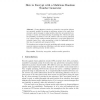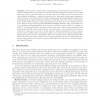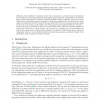89 search results - page 3 / 18 » Minimizing the use of random oracles in authenticated encryp... |
FSE
2008
Springer
13 years 7 months ago
2008
Springer
Chosen-plaintext attacks on private-key encryption schemes are currently modeled by giving an adversary access to an oracle that encrypts a given message m using random coins that ...
ESORICS
2009
Springer
14 years 6 months ago
2009
Springer
Abstract. Several generic constructions for transforming one-way functions to asymmetric encryption schemes have been proposed. One-way functions only guarantee the weak secrecy of...
ASIACRYPT
2000
Springer
13 years 10 months ago
2000
Springer
Assuming a cryptographically strong cyclic group G of prime order q and a random hash function H, we show that ElGamal encryption with an added Schnorr signature is secure against ...
IWSEC
2009
Springer
14 years 24 days ago
2009
Springer
Abstract—Password-authenticated key exchange (PAKE) protocols are designed to be secure even when the secret key used for authentication is a human-memorable password. In this pa...
ASIACRYPT
2008
Springer
13 years 8 months ago
2008
Springer
Every public-key encryption scheme has to incorporate a certain amount of randomness into its ciphertexts to provide semantic security against chosen ciphertext attacks (IND-CCA). ...



